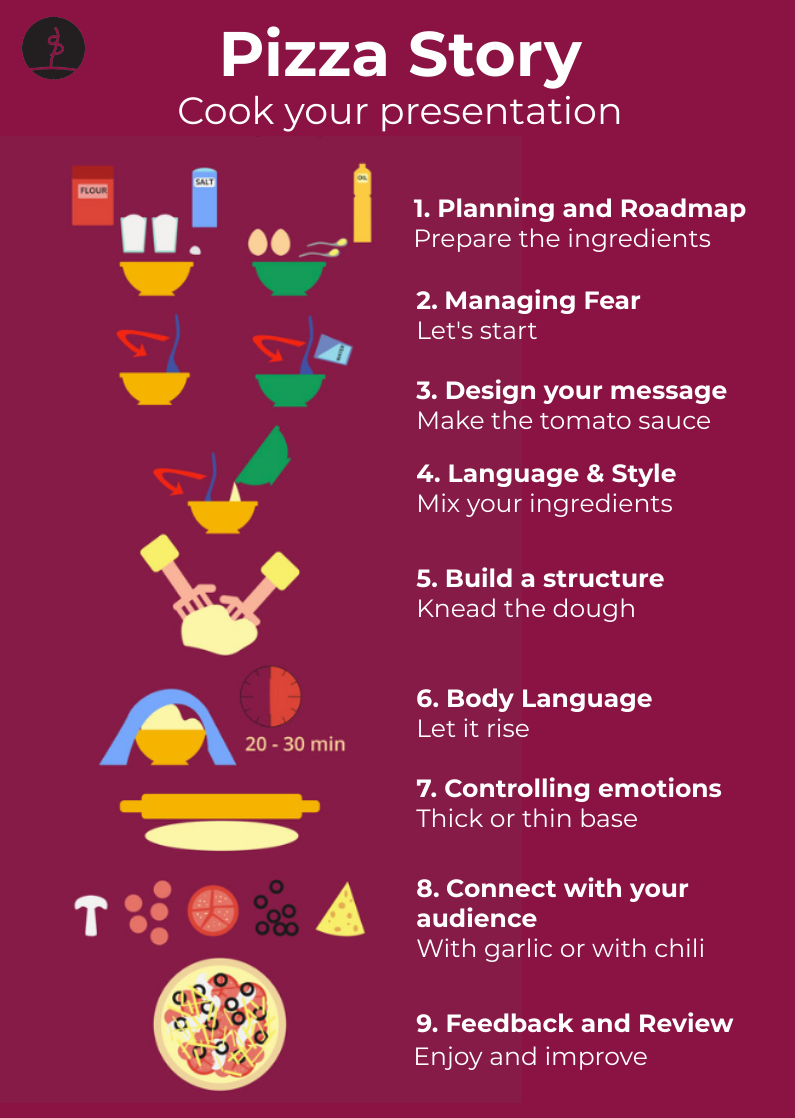
Where it all starts with Public Speaking
Preparing and delivering a great presentation is like making the perfect pizza. Read on for my 7 tried-and-tested ingredients for fearless communication. Hint: the secret’s in the sauce.
Along with death and spiders, speaking in public—or glossophobia—is one of the top three things people fear most. And, like death and taxes, we all inevitably have to face it sometime.
Many of us find public speaking uncomfortable; some even find it completely terrifying. Either way, it’s extremely energy-intensive. Know that feeling when you come off stage feeling like you’ve run a marathon? That’s because facing your fear is exhausting, and you’re trying to control what others think about you. Mission impossible!
It’s natural to compare ourselves to others at times. We all have that colleague or friend who always seems to present themselves so well, so convincingly and confidently.
What’s their secret?
How can we get some of that confidence for ourselves? If fear is an old friend in public speaking, you’ll recognise that nagging feeling of wanting to do something about it but not knowing where to start.
Well, fear no more. I’m going to walk you through 7 easy steps to improve your public speaking. My years of experience in communication coaching have led me to think of speaking in public, like preparing a homemade pizza from scratch. Here, I’m going to share my recipe for success so you have all the ingredients for effective communication and will be prepared and confident for your next public speaking engagement.

1) Brainstorm ideas and planning
I can’t stress enough the importance of this stage or how much time you need to invest, which will vary depending on whether it’s a new concept or a familiar topic. For example, talking about your thesis differs from explaining the results of a recent survey or improvising on a new topic.
At this stage, it’s very important to gather all the information you have and collect more if needed. This is the foundation of your presentation—the tomato sauce on your pizza. Make sure it’s well-prepared, and your information is valuable to your audience. Nice and tasty!
At this point, it’s good to ask yourself: What do I want to achieve with this presentation?
2) Structure the information and use connectors for flow
It’s time to work the dough that’ll be the base of your delicious pizza. What form and consistency will it be? Rectangular or round? Thick and soft or thin and crispy?
It’s essential to have a catchy beginning and a memorable ending. People remember these, not the good or mediocre stuff in between.
First impressions matter!
Here’s how to structure it:
– Introduction – say what you’re going to say about A, B & C.
Give the audience a warm welcome and introduce yourself if they don’t know you. Introduce your topic and the structure of your presentation: “Today I’m going to talk about A, B & C”.
If you’re unsure how to structure your presentation, use the Rule of 3. Choose 3 main ideas you want to talk about. i.e. “Firstly, A. Secondly, B. And finally, C”. You can also add subcategories within these 3 main ideas.
With every main idea, use connectors like “Let’s now focus on…; Secondly, I would like to talk about…; Last but not least…”.
– Conclusion – Say what you just said about A, B & C.
The conclusion is by far the most omitted part of a presentation. If you don’t conclude your presentation, you leave your audience hanging, closing the A, B, C loop. And, like a pizza with no cheese, that’s a definite no-no!
To avoid this common error, use similar words, rephrase and say the same thing in a different way. “So, in a nutshell,” or “To summarise” are great simple expressions to use to wrap up your show.
Check you’re on track by asking yourself: Is my message clear?
If you are feeling stuck for ideas on how to simplify your presentation structure, here you have a guide to help you: Tech Professionals guide to catchy introductions that connect and create curiosity.
3) Prepare your materials and venue for your presentation
This is where the Keep it Short & Simple [KISS] principle is invaluable.
Remember, less is more. Ask yourself, does every word add value? Using complex or technical words does not guarantee a better or more powerful speech. Use your words wisely and know your audience. Simple language and fewer words will always keep you on track.
If using PowerPoint slides, keep the following in mind:
- 3 keywords per slide.
- Use images; they speak louder than words.
- Use icons instead of keywords where possible, for the same reason.
- Use arrows for processes, movement or numbers.
- Will you use video linked to slides?
- Does your video have audio? Will you need speakers?
Other things to consider when preparing:
- Visit the place in person or take a virtual tour to get a feel for the space.
- Check equipment and audience seating at the venue.
- Save a PDF version of your presentation that can be opened anywhere with any program, as well as a backup on a memory stick or cloud storage.
- If running an online session, schedule a test run with 3 colleagues or friends to check links and Internet connection.
- Remember chargers for all devices, including an adapter.
- Pen & paper or notebook.
- Business cards.
- Pointer.
- Clicker.
- Cue cards or e-notes.
- Schedule and plan.
- Bottle of water.
Remember, you’ve got this!
4) Practice, practice, practice (your public speaking skills)
Luck is what happens when preparation meets opportunity.
Preparation and practice are the hundreds of pizzas you make and taste before you feel
comfortable putting them on your customers’ tables. Same goes for your presentation and your public speaking skills.
Apart from dealing with the actual fear of being criticised, ridiculed or hurt, this part is the most important and cannot be skipped. I recommend practising 3 times from beginning to end: a full dress rehearsal with all your material. That’s right, bake 3 pizzas, taste, get feedback and bake them again, only better. That’s how you get a feel for the real deal. Apply this to your presentation and it means you can mess up 3 times—fall off the stage, get blocked, even cry—and nobody will know. How cool is that?
Practice is so important in so many ways that I can’t stress it enough. Good, structured practice also means you familiarise yourself with your material. At this point, even the most perfectionist among you will begin to feel calmer and notice reduced levels of fear held in the body.
So how do you practice?
- Have your notes, slides and keywords to hand.
- Get a timer and mirror.
- OR camera on your phone and tripod.
- OR a friend.
- Start your presentation from the beginning, as if you were on stage, and don’t stop until the end.
- If you make a mistake, don’t stop or retake, just continue. Push through that fear.
- Repeat 3 times at least.
I’ll say it again, you’ve got this!
Whichever method works for you, you need to start loving the sound of your voice. Get over being embarrassed at this point; it doesn’t matter how your hair looks. You’ll delete these recordings anyway, as they are only for practice purposes. Taking the analogy back to our restaurant, it’s ok to drop a pizza on the floor; make another, better one.
Don't wait until you are confident to show up. Show up until you are confident.
5) Check your body language whilst presenting
– While practising
While you were practising in front of the mirror and filming yourself, you would have got an idea of what your body was doing. Filming your whole body or getting a friend to help is useful here. Otherwise, you run the risk of only seeing what you want to see. Sometimes you won’t even see that because you’re so focused on the words you want to use. Remember also to check what your feet, hands, shoulders, face and eyes are doing.
A handy trick is to mute the video when watching a third time. This way you can focus on observing the body alone.
– On stage
Don’t talk to the walls; remember to face the crowd, not your slides. Some people naturally stand still, others move more and some have expressive hands. You’ll eventually find your own style, whatever it is.
Also, remember to wear comfortable clothes and shoes so you can move freely and gracefully when presenting.
Ask yourself: Where is the audience?
You’ve got this!
6) Use these 3 ways to connect with your audience
1 Numbers
Including some interesting numbers arouses curiosity. Use them to present yourself, a product or service. And be imaginative: instead of saying how many years’ work experience you have, what about how many clients you’ve helped? If you’re a translator, how many words have you translated in the last week/year? Put your numbers into perspective to stimulate the audience’s curiosity.
2 Familiarity
When describing your product’s features, compare them to something universally familiar. For example, if you’re talking about Test-Driven Development, you could say it’s the same testing process after every unit (like a chef who tastes the food at different stages).
3 Story-Teching
Story-teching is the ability to explain something technical so everyone understands. To do it, keep concepts short and simple, simplify your language, and use numbers, adjectives, comparatives, universal metaphors, and anything else you can think of. As the person communicating—the Sender—you are 100% responsible for making sure your audience understands you.
Remember to get to know your audience so you can adapt your language accordingly. If you are in doubt or unfamiliar with your audience, it’s always better to keep it simple than assume they know. Difficult or tech-heavy vocab will not make your presentation better. What makes a great presentation better is YOU and your ability to talk and communicate in front of others—AKA meaningful public speaking and a meaningful message.
7) Review and get feedback
Now you’ve got your pizza base rolled out, let’s focus on your performance, a combination of preparation and review.
Whether it’s an investor pitch, an internal meeting or a global summit—and regardless of whether it goes well or not—always take a moment to summarise your experience after the speech or event. Learn to regularly give yourself feedback, review your work afterwards and be creative so you can improve even when you don’t get the result you were hoping for.
Learn to spot what went well, and what can be improved; what worked and what didn’t. And remember, it’s not always what you think. That’s why it’s also important to be open to feedback and ask for constructive feedback when possible.
When receiving feedback from others, remember:
- Listen carefully and thank the person giving it.
- You might disagree with it, but that doesn’t matter, you can disregard it later. For now, listen and acknowledge.
- There’s no need to explain or comment. No excuses, ifs or buts; listen and take in the information. Smile and nod.
When giving yourself feedback, remember:
- Be specific, kind and relevant.
- Take a step back and focus on what worked and what can be changed, not on
what went wrong or badly. Be a detached observer, not a critical judge.
Remember, giving a presentation and making a pizza are both a matter of trial and error. Keep going until you get your perfect thin base, calzone or carbonara.
At the end of the day, what matters is that you made an effort to put your pizza on the table and that it was the kind you most enjoy making and eating.
Be a creator, not a critic.
If you are curious about the benefits of working with a Public Speaking Trainer, here is an article on this topic: 3 ways a Public Speaking Trainer can help you build confidence
To wrap it all up
So, there, in a nutshell, you have 7 easy steps to improve your public speaking. As I said, I think that preparing the perfect presentation requires similar skills to making a pizza. Before you go off to the kitchen to get those ingredients ready, let’s recap this recipe for success:
- Brainstorm ideas and planning.
- Structure the information and use connectors for flow.
- Prepare your materials and venue.
- Practice, practice, practice.
- Check your body language.
- Use 3 ways to connect with your audience: numbers, adjectives and Story-Teching.
- Review and get feedback.
Add a handful of confidence and a pinch of courage to that winning formula and you’ll be well on the way to improving your public speaking!
Looking ahead: What’s next?
If you have read this far and are excited about improving your presentation skills, I have three actionable items that will take you one step closer to making this happen.
- You can download your Master Checklist, which guides you from A to Z to ensure you don’t miss any crucial steps in your presentation preparation, here.
- Purchase my online course on Public Speaking, “A Presentation Skills 101 course | Master Public Speaking and Overcome Stage Fright Like a Pro”
- Book your 30-minute introductory call with me here for free. Let’s discuss your vision and how you can achieve it.
Related articles: The Emotional Journey of Fear, where does it come from? and How to overcome the challenges of PSL (Presenting in a Second Language)
Until next time!
Cheers,
Anne Pirkkanen

Public Speaking & Communication Trainer
Bio: About Me
WEB: Version 2 of ME Communication
LinkedIn: Anne Pirkkanen
Bookings: Calendly




